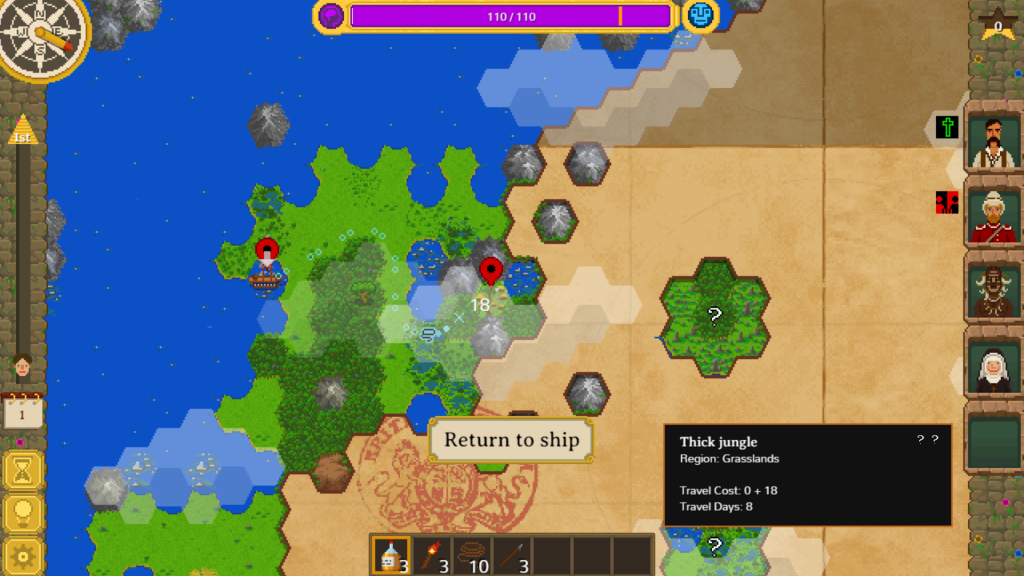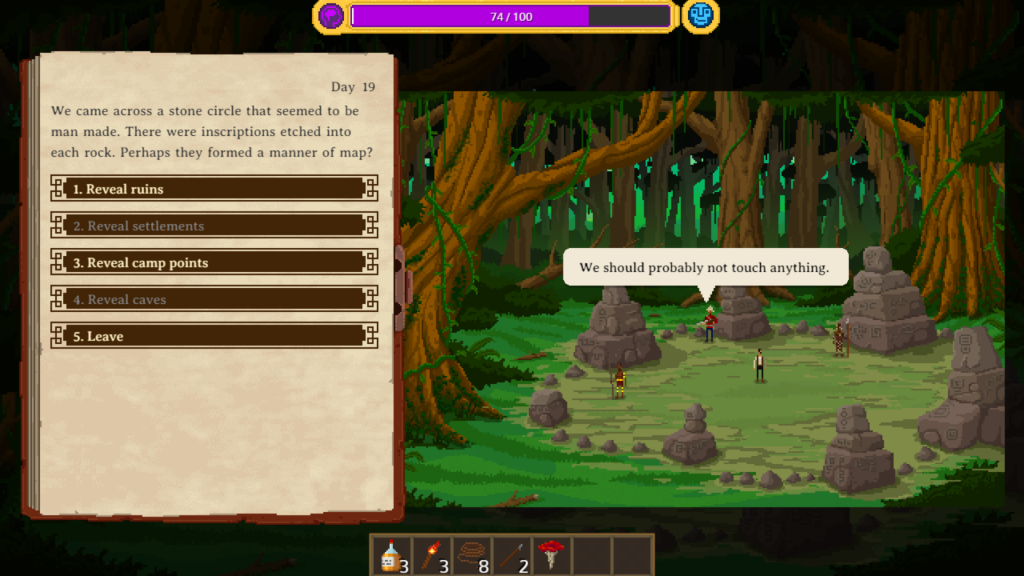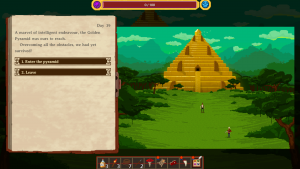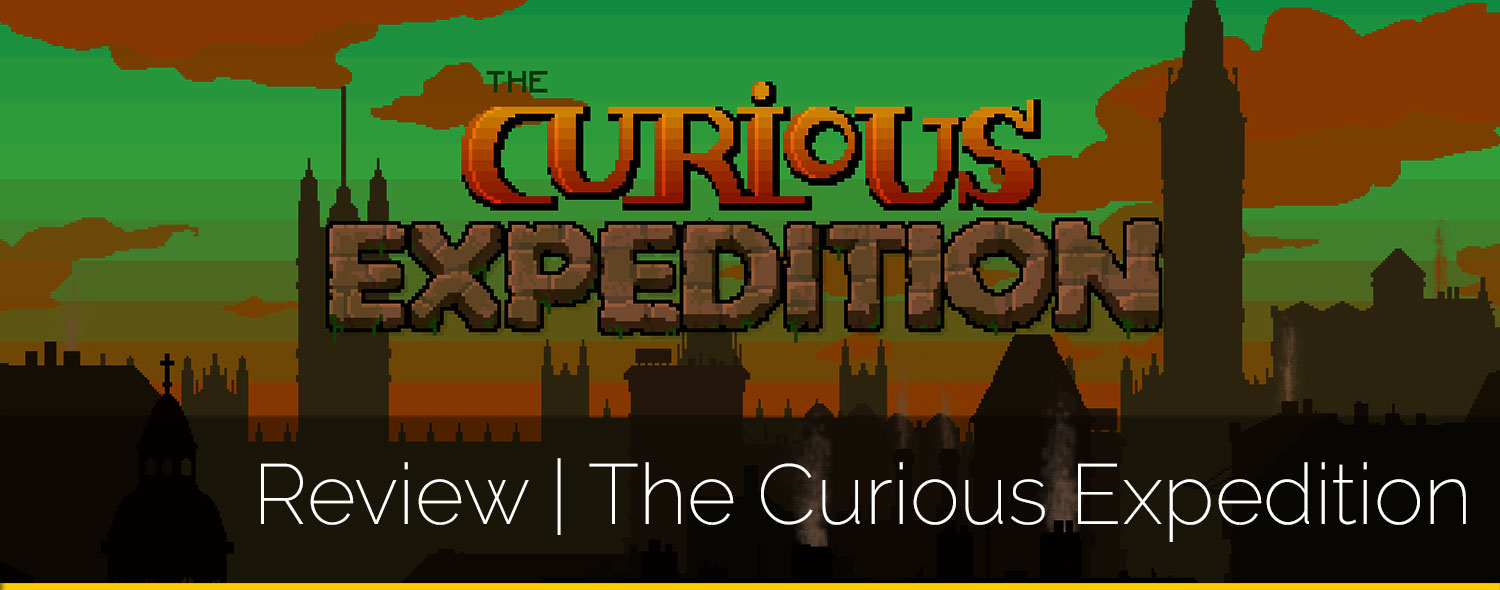If you’ve ever daydreamed about travelling the world and exploring distant, undiscovered lands all in the name of fame, fortune and beating other famous explorers, then you should give The Curious Expedition a look. This challenging roguelike allows you to choose your own path through a series of procedurally generated environments; visiting villages, investigating ruins and caves, braving mysterious temples and traversing formidable landscapes to find the illusive golden pyramid that signals the end of your journey and the scoring of points! Tasty, tasty points!
You begin your trek by choosing which famous 19th Century explorer you would like to be – does Marie Curie appeal to your persona-assuming side, or maybe good old Charles Darwin is really who you’ve always wanted to be? The choices are endless….well, OK, with Richard Francis Burton and Mary Kingsley joining the options you actually start with 4 choices, but each one will affect your gameplay in different ways, so choose wisely (or pick randomly, as I did…)

Once you have made your decision, a caddish looking man swilling a glass of brandy and sitting suggestively next to a roaring fire informs you that you’re part of an explorers club, and that you, along with your other club-mates, are involved in a competition to gain the most fame by completing 6 expeditions with the winner rewarded with a statue of themselves. Seems legit. You are then given 3 difficulty levels to choose from – tourist trip, expedition and certain death. I chose tourist trip, being but a novice explorer, however I may as well have gone all out for all the good it did me.
The Curious Expedition is by no means an easy game. Once you select a difficulty you are presented with a map and a flag indicating the only destination for your maiden expedition. After successfully completing an expedition you are returned to the map and presented with more destination choices. The destinations have suitably vague names, a short description and even vaguer symbols which I think are supposed to indicate the type of terrain you will encounter, but as this is not explained, I could be wrong.

After selecting your destination you are then given some story, an initial side-quest to complete and the options of whether to accept or refuse it. You are generally presented with a side-quest at this point for every expedition which can influence your game play, for example, find a person will gear you towards finding a settlement, bring back an item insights you to find a shrine or complete in x amount of days means head straight for the goal. If you accept a side-quest and do not complete it you risk losing fame or other stats upon your return, however I generally found it was worth accepting regardless, particularly at this stage. In later iterations of this process you can also take on new recruits, although the benefit of doing this after you have a full crew who you have spent time levelling up was lost on me, and there is a maximum capacity on crew members. However, on this first mission, after you have made your choice you are ready to set sail, so let’s do that.
The land you are bound to explore is divided into hexagons which uncover themselves in a radius around you as you move about. Points of interest are marked with question marks until you get near enough to explore them and your current crew members are displayed on the right of the screen. The approximate directions of your overall destination and journey goal is indicated by a compass in the top left of the screen. As your ship nears the shore the land begins to uncover and, once docked, you have the chance to access the ship’s storage, refill your water or simply begin your exploration.
To start with there is nothing in your ships storage. I started by refilling my water at this point, but as I found I never actually used any water on any of my expeditions (probably due to the type of terrain available – I think maybe desert lands may have required this more), I stopped doing this as it takes up a valuable loot spot in your inventory. Therefore, with a full sanity meter, some whisky, torches, rope and spears (the default starting equipment) I selected to venture forth and begin my expedition.

The starter side quest involved taking someone to a village which she had kindly pinpointed on my map, changing a nearby question mark into a Google Maps style marker (which is very technologically advanced for the time-setting), so I headed there. To move around you can hover over and uncovered hexagon which displays a dotted trail and a number. The dotted trail signifies the path your party will travel to get there (to allow you to assess the type of terrain you will encounter) and the number signifies how much sanity travelling will cost you.
Considering the terrain becomes important as moving through more challenging environments will have an effect on the length of time it will take to reach your destination. Throughout the game you can pick up equipment and perks which will allow you to move more easily through certain types of terrain so this becomes more important as you progress. Hovering over the hexagons on your map will tell you what type of terrain it is, and what effect that will have on your travel time.
Your sanity meter is effectively your life bar, although dropping below 0 will not immediately kill you, it will make your journey much more challenging, with the psychological effects on yourself and your crew taking increasingly insidious turns and forcing you to make difficult decisions in order to complete your mission. You can regain sanity through various means, including eating or drinking certain items, resting overnight at villages and rest points, and by winning battles, but we’ll come to that a bit later.

After travelling to the initial way-point on my map, the option to ‘Enter Village’ appeared, and so I did just that. Once you enter an explorable area the UI changes from the map to a story-book looking design, with narrative and options displayed on a page on the left and an illustration of the area to the right. Your sanity meter is always displayed at top and your inventory always at the bottom of the screen. Depending on what you find in the explorable region you will gain a series of possible interactions. For villages this tends to be trading with the locals, resting and recruiting, for ruins it involves uncovering certain types of nearby points of interest, shrines and caves again have their own set of options and if you are somewhere relevant to a side-quest you also have options for that, each option usually has an effect on at least one of your stats. My current side quest was to deliver a missionary to the village I was now in, so one of my options was ‘deliver missionary’, which I did and was rewarded with +2 standing and some sanity.
The trading system involves balancing the worth of items you want against items you have to trade. Each item has a value, and once your trade is balanced a green tick is displayed and your are able to make a deal. Gathering the right supplies is crucial to a successful mission as being stuck in the middle of nowhere with no sanity left and no items to replenish it is no fun at all and can be avoided by buying some useful mountaineering gear or other equipment to make travel easier and therefore quicker (read: less sanity-depleting).

Recruiting people efficiently involves understanding how the battle system works, requiring you to decide which traits you are most in need of to fight effectively. Each potential recruit has three types of attribute – dice (denoting what skills they bring to battle), toughness (how much life they have in battle) and capacity (how much they can carry), there are also some icons which indicate personality traits (such as alcoholic, claustrophobic, etc). Extra capacity means extra boxes in your inventory, and is always a good thing as I found mine got full very quickly – if you are carrying more equipment than you have capacity for you become overburdened, slowing down travel and speeding up sanity-loss.


Battles are based on a dice-rolling system. Depending on your team you will have different types and amounts of dice to roll, rolled dice combine to make different battle moves, be that attack or defence, depending on the type of dice. Red dice are attack dice, and are generally held by soldiers or warriors, green dice are defence dice and are usually found on missionaries, blue dice are intelligence or logic, purple are psychic or mystical abilities (e.g. healing for your party or poisonous attacks). Special dice can also be added depending on equipment, for example, bullets can be used to add a gun-type attack dice. Each time you roll you can combine as many dice as you like to create a move until your dice have run out or no possible combinations exist, you can re-roll unused dice up to 3 times. Once all re-rolls have been used and any combinations have been played you must end your turn and the enemy gets to attack. Play continues until one party is defeated (hopefully them). If victorious you are rewarded with some sanity and the option to loot the fallen foe.

To begin with this battle system is incredibly confusing until you realise that dice with possible combinations on the board shake slightly to denote they can be chosen and, as you play, you begin to learn which dice make which combinations. Once you have it down, it actually becomes a brilliantly enjoyable little mini-game and I was impressed by how unique it felt, allowing you to build your own type of combat by considering which dice you need most, and affecting your decision making in other parts of the game (trading, hiring, levelling, etc.) It could, however, do with some documentation – even after playing through the tutorial I still didn’t understand properly and had to make it up as I went along until I got the hang of it. Even just some starter combinations would have been handy to have on-screen in the easy difficulty.
The UI is also not very self-explanatory. I eventually worked out the purpose of the compass and that the left-hand side denotes how you are currently comparing to your competitor explorers in terms of time taken on your current expedition (completing your journey in the fastest time adds points at the end). Learning how to bin items from your inventory was another uphill struggle and even cancelling actions and movement was a bit counter-intuitive. The gameplay became not only about exploring the land on the screen, but also exploring the game itself and learning what means what and how that should the affect your progression through the expedition.
It was odd, then, that so many of the aspects of the game actively discouraged exploration – the constraints of the sanity bar held me back from heading off to uncover far-flung areas of the map, as did the extra points for returning home first; comments by your crew when investigating ruins and remains, and the negative effects invoked by interacting with and looting areas meant that most of the time I travelled the path of least resistance which made most of my expeditions relatively predictable.


The few times I did travel off-course I found it easy to get into an unrecoverable situation whereby I only encountered unhelpful settlements and ruins with no useful loot, ran out of sanity with no items to replenish and therefore couldn’t really travel anywhere without incurring increasingly harsh consequences which ended up in me losing most of my crew, which in turn meant I lost most of my attack dice creating a basically hopeless situation. The fact that you can’t see what the points of interest are until you reach them means that plotting a course is basically impossible and you’re playing on guesswork the whole way through.
Once you uncover enough of the world, and providing you’ve gone in the right direction, eventually the golden pyramid will appear on your map. Head towards it and choose to explore to end your current expedition and receive your points. You are then greeted by a cheering crowd and able to select one of three available perks to aid you on your subsequent expeditions (this includes things such as aided movement over certain terrain or ability to hold more items in your inventory).

Finally, once you’ve chosen your perk you then get to distribute the items you have returned with by either donating them to a museum in return for fame points, auctioning them off in return for money or keeping them for yourself to take on your next expedition. You can also see where you are in relation to your competitors on a leader board which will help you to decide what you need most (fame or money). You can also choose to view your expedition log at this point, which takes you to a custom generated web page containing the main points of each expedition so far, and is a nice touch. Once all your items have been distributed you’re sent back to the map to choose your next expedition and the cycle starts again.
Selecting perks was a little pointless in the easy difficulty level, as was a choice of expedition as there wasn’t really much variety. I imagine higher difficulty levels make perks and crew abilities much more relevant when selecting which expedition you want to undertake at each stage.
The final expedition throws you a bit of curve-ball, requiring you to complete certain areas before you are able to get to the golden pyramid, which is a nice way to change things up a bit, although annoying that you only discover this AFTER reaching the pyramid for the first time – by which point you’ve probably used most of your sanity and supplies, making this too difficult when you’re not expecting it. The first time round I managed to hold on long enough to hit all three requirements and begin to make my way back to the goal pyramid, then my luck ran out, I was attacked by a raptor and I got game over. And because the game is roguelike that means “start from expedition 1, sucker”.
Playing The Curious Expedition was an interesting experience for me. Initially I was geared up to hate it – the difficulty level seemed far too harsh, and I felt like I’d been thrown in totally at the deep-end without my water wings and duck-shaped rubber ring. I felt like the random generation was unfair and the inability to route plan, abundance of useless shrines and temples and distinct lack of useful traders or rest points made the gameplay an uphill struggle. However, as I carried on playing and got to grips with the battle system, UI and managed to work out some basic tactics I found myself enjoying playing more and more. Although the original points still stood, they seemed like less of a barrier to my enjoyment.
Given the opportunity to explore the game properly, and taking the time to get angry, shout and rage-quite a few times I still found myself coming back to play some more. The overall experience is a fairly unique one, combining resource management with decision-based story and an intricate battle system it becomes a learning experience with each decision or mistake you make influencing how you continue to play the following expeditions. The lack of documentation, with only a brief and basic tutorial level available, helps to encourage trial and error learning, however this can go too far in that a lot of the UI and controls are not immediately obvious so this could do with being a bit more balanced.
Whilst the choice to make an 8-bit style exploration games seems a little bit odd to me and it would have been nice to make more of the environments you explore graphically, the overall effect is not off-putting, and helps to simplify the map view whilst providing enough detail in the narrative-driven sections of the game.
I think further play would have eventually allowed me to hone the ability to predict exactly which items I would need and in what quantities to avoid the unrecoverable situations – and maybe eventually get on to the ‘normal’ difficulty level!
